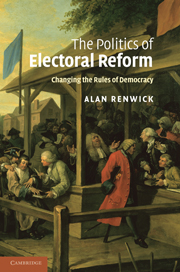Book contents
- Frontmatter
- Contents
- List of tables
- List of figures
- List of abbreviations
- Acknowledgements
- 1 Introduction
- PART I Building blocks
- PART II Elite majority imposition
- PART III Elite–mass interaction
- 9 Italy: diluting proportional representation
- 10 Japan: the abandonment of SNTV
- 11 New Zealand: MMP in a Westminster setting
- 12 Elite–mass interaction: comparative analysis
- 13 Conclusions and implications
- Appendix: glossary of electoral system terminology
- Bibliography
- Index
11 - New Zealand: MMP in a Westminster setting
Published online by Cambridge University Press: 04 May 2010
- Frontmatter
- Contents
- List of tables
- List of figures
- List of abbreviations
- Acknowledgements
- 1 Introduction
- PART I Building blocks
- PART II Elite majority imposition
- PART III Elite–mass interaction
- 9 Italy: diluting proportional representation
- 10 Japan: the abandonment of SNTV
- 11 New Zealand: MMP in a Westminster setting
- 12 Elite–mass interaction: comparative analysis
- 13 Conclusions and implications
- Appendix: glossary of electoral system terminology
- Bibliography
- Index
Summary
As I argued in Chapter 1, the electoral reform in New Zealand in 1993 has a good claim to being the most momentous of all the reform episodes studied here: over eighty years' uninterrupted use of single-member plurality (SMP) were ended in favour of mixed-member proportional representation (MMP), a form of PR never previously used in the Westminster world. In no other case of post-war electoral reform has such a long-standing system been so comprehensively overturned.
The process that led to this change was, as two of its leading students observe, ‘long and winding’ (Levine and Roberts 1997: 25). A Royal Commission reported in favour of replacing SMP with MMP in 1986 (Royal Commission on the Electoral System 1986), but its recommendation did not initially spark wide enthusiasm, and the proposal could easily have been shelved. Only an improbable combination of factors – the strategic actions of certain key individuals and groups, the miscalculations of others, the dynamics set up by the Royal Commission, and growing public dissatisfaction with a political class that was perceived as having pursued radical economic reforms without regard to the wishes of the electorate – kept the matter on the agenda. In the end, two referendums were held. The first, in September 1992, asked voters two questions. One question simply asked whether the existing electoral system should be retained or changed. The other question offered four alternatives to the status quo and asked voters which they would choose supposing that reform did take place.
- Type
- Chapter
- Information
- The Politics of Electoral ReformChanging the Rules of Democracy, pp. 194 - 209Publisher: Cambridge University PressPrint publication year: 2010



